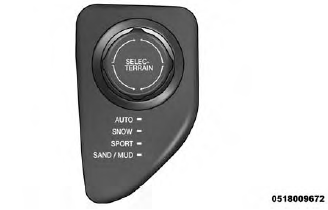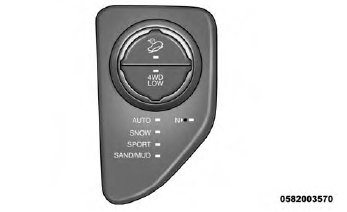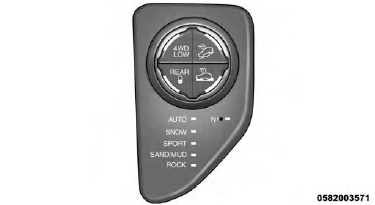Jeep Cherokee (KL): 1-Speed Four-Wheel Drive (4X4). 2-Speed Four-Wheel Drive (4X4). Shift Positions
This feature provides on-demand four-wheel drive (4X4).
The system is automatic with no driver inputs or additional
driving skills required. Under normal driving
conditions, the front wheels provide most of the traction.
If the front wheels begin to lose traction, power is shifted
automatically to the rear wheels. The greater the front
wheel traction loss, the greater the power transfer to the
rear wheels.
Additionally, on dry pavement under heavy throttle
input (where one may have no wheel spin), torque will be
sent to the rear in a pre-emptive effort to improve vehicle
launch and performance characteristics. CAUTION! All wheels must have the same size and type tires.
Unequal tire sizes must not be used. Unequal tire
size may cause failure of the power transfer unit.
The Four-Wheel Drive is fully automatic in the normal
driving mode. The Selec-Terrain buttons provide three
selectable mode positions: When additional traction is required, the 4WD LOW
range position can be used to provide an additional gear
reduction which allows for increased torque to be delivered
to both the front and rear wheels. 4WD LOW is
intended for loose, slippery road surfaces only. Driving in
4WD LOW on dry, hard-surfaced roads may cause increased
tire wear and damage to driveline components.
When operating your vehicle in 4WD LOW, the engine
speed is approximately three times that of the normal
driving mode at a given road speed. Take care not to
overspeed the engine and do not exceed 25 mph
(40 km/h).
Proper operation of four-wheel drive vehicles depends
on tires of equal size, type, and circumference on each
wheel. Any difference will adversely affect shifting and
cause damage to the driveline components. Because four-wheel drive provides improved traction,
there is a tendency to exceed safe turning and stopping
speeds. Do not go faster than road conditions permit. For additional information on the appropriate use of each
4WD system mode position, see the information below: NEUTRAL This range disengages the driveline from the powertrain.
It is to be used for flat towing behind another vehicle.
Refer to "Recreational Towing" in "Starting And Operating"
for further information. WARNING! You or others could be injured or killed if you leave
the vehicle unattended with the power transfer unit
in the NEUTRAL (N) position without first fully
engaging the parking brake. The NEUTRAL (N)
position disengages both the front and rear driveshafts
from the powertrain and will allow the vehicle
to roll, even if the automatic transmission is in PARK
(or manual transmission is in gear). The parking
brake should always be applied when the driver is
not in the vehicle. 4WD LOW This range is for low speed four-wheel drive. It provides
an additional gear reduction which allows for increased
torque to be delivered to both the front and rear wheels
while providing maximum pulling power for loose,
slippery road surfaces only. Do not exceed 25 mph
(40 km/h). NOTE: Refer to "Selec-Terrain - If Equipped" for further
information on the various positions and their intended
usages.1-Speed Four-Wheel Drive (4X4) - If Equipped

1-Speed 4X4 Switch2-Speed Four-Wheel Drive (4X4) - If Equipped

2-Speed 4x4 Switch
2-Speed 4x4 Switch (with Rear Lock)
Shift Positions
Other materials:
Connecting rod bearings-fitting
Inspect the connecting rod bearings for scoring and
bent alignment tabs (Fig. 28) (Fig. 29). Check the
bearings for normal wear patterns, scoring, grooving,
fatigue and pitting (Fig. 30). Replace any bearing
that shows abnormal wear.
Inspect the connecting rod journals for signs of
scoring, ...


